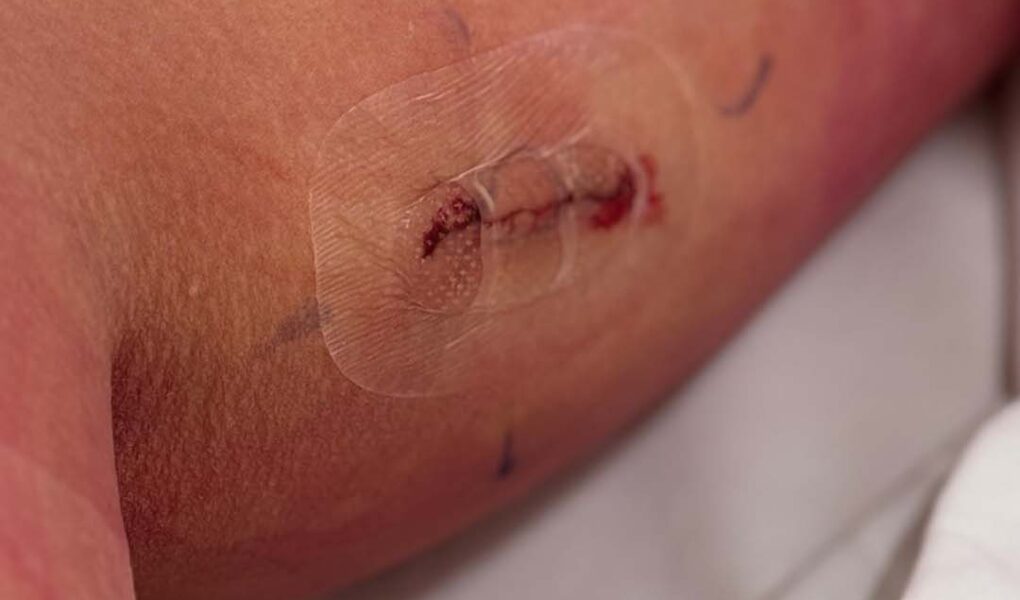Views: 764
Six weeks is a long time to sit in the unknown. Long enough for your mind to play out every possible scenario. Long enough to feel your world shrink, your priorities sharpen, your patience wear thin.
That’s how long I waited — six weeks — to find out whether the 11mm tumour growing in my calf was cancerous. Not just cancer, but the aggressive kind. The kind that spreads quickly and quietly, that doesn’t always come with a warning.
The Niggle That Wouldn’t Quit
It’s ironic really. As a lifelong hypochondriac, I’ve always been convinced I’d get cancer. I was the kid who watched Home and Away and thought, “If it’s not the Summer Bay stalker that gets me, it’ll be the inevitable cancer diagnosis.”
So it’s surprising that when I started feeling sharp, lightning bolt jolts up my left leg — or a constant dull pain and ache, like I’d pulled a muscle or gone too hard at the gym — I didn’t immediately panic. “It’s probably sciatica,” diagnosed Ned, my boyfriend and live-in dentist (not a GP, for the record, despite me treating him like one).
When the pain became a daily annoyance, sometimes even a hindrance to my movement after our trip to Fiji in January, I was convinced I had DVT (deep vein thrombosis) and took myself off to the GP. With zero other DVT symptoms (and a well-known reputation for crying over spilt milk), she sent me off with a recommendation to see my osteo and a referral for an ultrasound “if you would feel better doing that“.
Once again, uncharacteristically, I did neither.
I pushed it to the side, got on with life. I was too busy, my leg felt fine today, rent was due, and was there even a radiology place nearby? It wasn’t an injury. It wasn’t even particularly painful most days. Just an odd niggle in my leg that I brushed off for far too long, because life was busy. I had deadlines, shoots, social events and travel.
I put it off, thinking: I’ll deal with it later and besides, it was probably sciatica anyway.
By May, though, it wasn’t just a niggle. It was constant radiating pain in my calf, thigh and foot. I had pins and needles, and felt discomfort whether I was lying down, sitting or standing. Painkillers were useless. So, I finally unearthed the referral gathering dust in my drawer and booked the ultrasound.
When Your Worst Fears Start To Take Shape
There is nothing more humbling than lying face down, pants off in a g-string (wishing you had worn something with a bit more coverage), legs slick with gel while a stranger presses painfully into your calf. Then comes the dreaded words, “Just wait here a moment, I’m going to see if the doctor wants to take a look”.
Her face told me everything I needed to know, or rather, everything I didn’t want to know. It was at this moment that I realised I definitely didn’t have sciatica.
After the longest week of my life waiting for the ultrasound results, my GP called me and told me they had found “an 11mm mass” on my left calf but that they couldn’t tell me much more than that, and suggested I get a MRI.
Three sentences: “They’ve found an 11mm mass. Suspected nerve sheath tumour. You’ll need an MRI.” Cue the doom-scrolling.
Google informed me that nerve sheath tumours can be benign (good) or malignant (bad). They can be Schwannomas (common and non-cancerous), neurofibromas (typically genetic), or malignant peripheral nerve sheath tumours (rare, but viciously aggressive and definitely cancerous).
I decided to stop scrolling for fear I would encourage a full-blown meltdown, and instead, left all the researching and Googling to Ned.

In summary, there were far too many mentions of “cancer” for my liking and I booked the next available MRI, which thankfully happened to be in 20 minutes. Ned showed up at the appointment unannounced and held my hand as I sat, totally frozen, mute and numb.
“Usually, if it’s something serious, our doctor will call yours today!” the chirpy nurse reassured me as she stuck a needle into my arm that would put dye in my body, making the MRI easier to read. So I, of course, spent the rest of the day staring at my phone, not sure if I wanted it to ring or not.
It didn’t. But the dread never lifted.
The Call, The Cancer Cloud, And The Waiting
Another agonising few days waiting for the MRI results, and the diagnosis was official: nerve sheath tumour. Suddenly, I was receiving calls, emails and texts from ‘The Cancer Specialists’ and my whole world felt flipped on its head.
Every conversation ended with: “We won’t know until the biopsy results.’

My specialist was confident it was nothing to worry about, but simultaneously referred me to “Peter Mac” (what I now know is the colloquial name for the Peter MacCallum Cancer Centre) for a biopsy because “the best place to tell you that you don’t have cancer is a cancer centre!”
If only I could have shared in his optimism. Instead, I spiralled.
I spent weeks waiting for an appointment to pop up, convinced I was dying. Convinced I had the rare, especially aggressive form of tumour, just quietly growing in my leg.
I told no one. Not my friends, not my family. I couldn’t bear their concern layered on top of my own. So instead, I carried it alone, with only poor Ned as my trench-mate.
I went on posting on my social media feeds as normal, as if everything was business as usual.
I went to Bali (cleared by my doctor) and helped host a week-long mindfulness and fitness retreat, supporting other women through their pain and trauma, while secretly believing I was on the brink of my own.
I threw myself into my work with Y-Care and Dementia Australia, attending the Sydney Memory Walk & Jog and organising a Melbourne meet-up for young carers living with dementia.
I worked tirelessly behind the scenes on my new podcast. Presenting pitch decks and hustling to secure a launch sponsor, wanting so much to make it a success and not let my co-host and dear friend down.
I continued to plan our big European summer holiday — my first. Booking dinner reservations and sorting out wedding outfits, unsure if I’d even be able to make the trip.
I smiled at dinners with friends, and at nail appointments. Trips to the supermarket. Banal chats with kind strangers at the dog park.
Meanwhile, the cancer cloud hovered, heavy and suffocating.
It was torture. Enormously isolating and, understandably, terrifying.
I was scared. I was really bloody scared that this stupid “niggle” in my leg, something I’ve known about for months but ignored, would actually be my undoing. Scared that all my dark jokes about my sore leg being cancer had somehow manifested into actual cancer. Scared that I’d spent my life expecting to inherit my mum’s younger-onset dementia, only for cancer to get me first.
But mainly, I was scared that I hadn’t done enough.
That I hadn’t loved Ned hard enough. That my diagnosis would be the final unravelling for Dad, who’d already been dealt enough heartbreak to last several lifetimes. I was scared for my life, but mainly for the people in it.

The Six Days That Felt Like a Lifetime
After an excruciating biopsy and an even more horrific six-day wait, just as we were about to board our flight to Europe, the call came: benign. Not cancer.
I got lucky. The tumour wasn’t cancerous, but for six weeks, I lived as though it might be. And here’s what that limbo taught me:
1. The small stuff really is small
Firstly, what you think matters? It often doesn’t. At least, not in the way you think it does. The things that felt urgent, like emails, bills, Instagram likes, who said what, all evaporated into insignificance. In their place? Quiet things.
Am I spending enough time with the people I love? Am I proud of the life I’ve built? Have I seen enough sunsets? I wasn’t thinking about my inbox. I was thinking about whether my niece would remember me if I wasn’t around.
2. Everyone is carrying something
Secondly, you have no idea what someone else is going through. We judge easily, scroll mindlessly and comment flippantly. Yet any given person you pass on the street could be waiting for a biopsy result. They could be carrying a life-altering fear in their back pocket while posting happy snaps on their feed. We never know. And yet, we’re not as kind or forgiving or patient with one another as we should be.
We don’t give each other nearly enough grace, as human beings who are all just trying to do our best. I want to be better at that.
3. Pay attention to your body.
Lastly, and perhaps most importantly, listen to your body. Don’t wait for the pain to become unbearable. Don’t ignore the thing that doesn’t feel quite right. I regret not getting it checked sooner. I regret thinking I was too busy to prioritise my health. That’s a dangerous story we tell ourselves, that we’ll deal with it later but sometimes, later doesn’t come.
When the biopsy results came back, I cried with relief, gratitude, exhaustion. But I also promised myself something: to pay attention. To myself. To my health. To my people. And to the invisible battles others might be fighting.
Because the truth is, you never really know, until you do.
A personal note from me:
I want to sincerely thank Professor David Gyorki and Katie Wendt at The Cancer Specialists for their kindness, professionalism, and unwavering support – they’ve gone above and beyond for me, and I’m so grateful.
A huge thank you also to Dr David and the incredible nurses Courtney and Dayle at the Peter MacCallum Cancer Centre for their patience, kindness, humour, and reassurance during my biopsy.
Special shoutout to Nurse Courtney and her bright, cheerful scrubs and Crocs — you have no idea how much they helped.
The post What A Cancer Scare Taught Me About Life, Kindness And Paying Attention to Our Bodies appeared first on ELLE.



